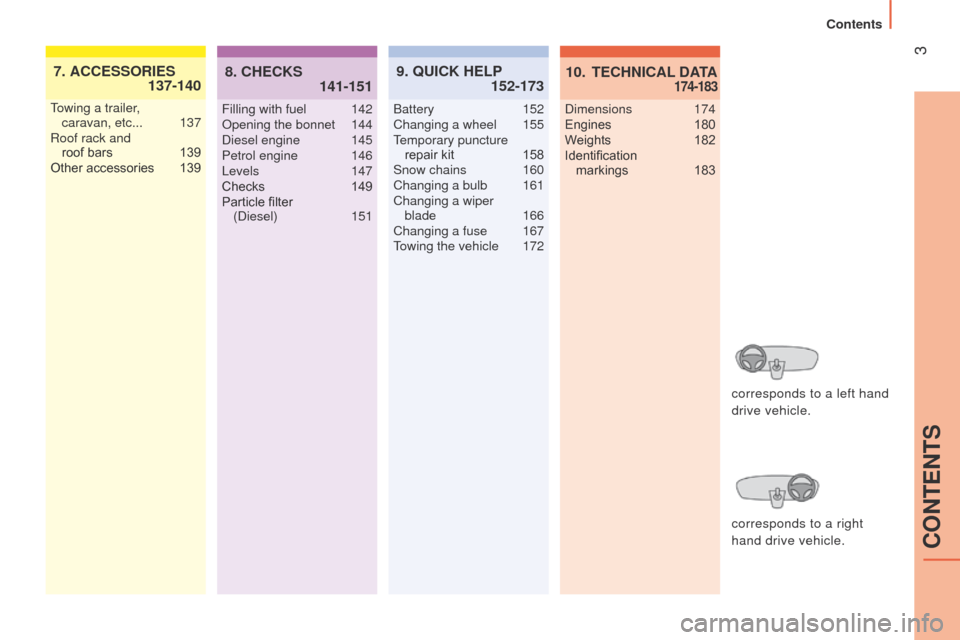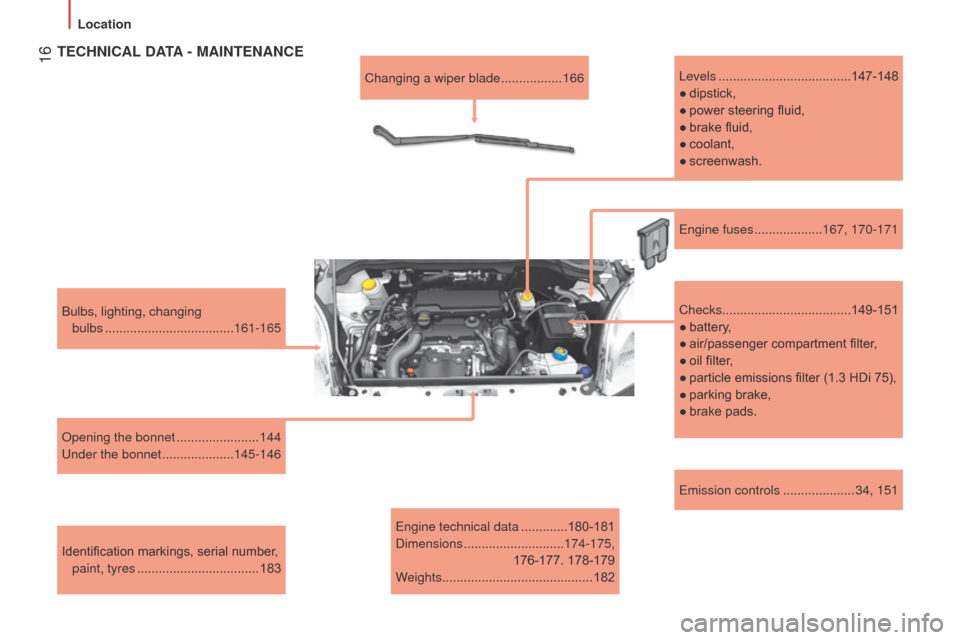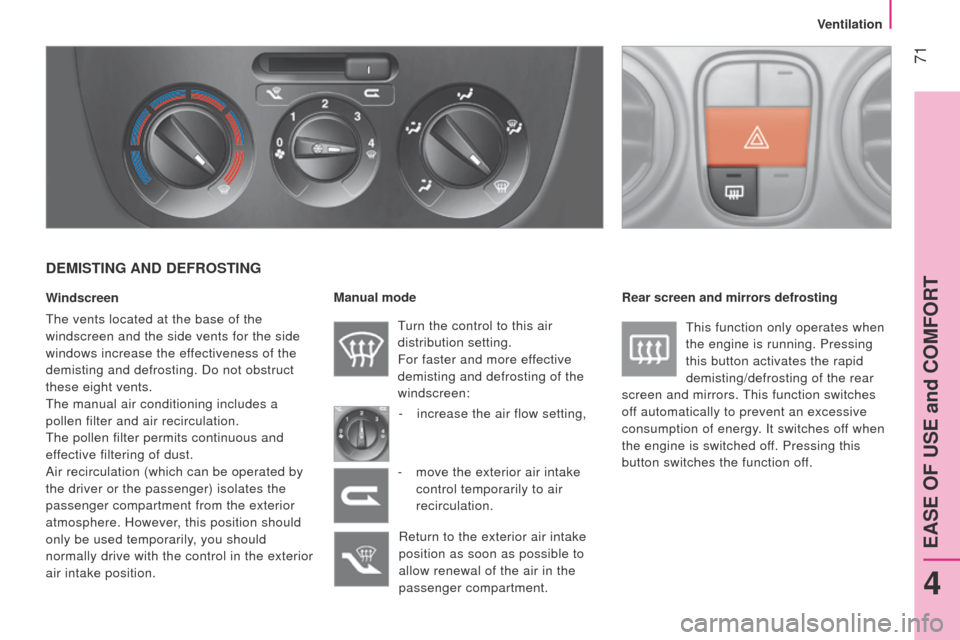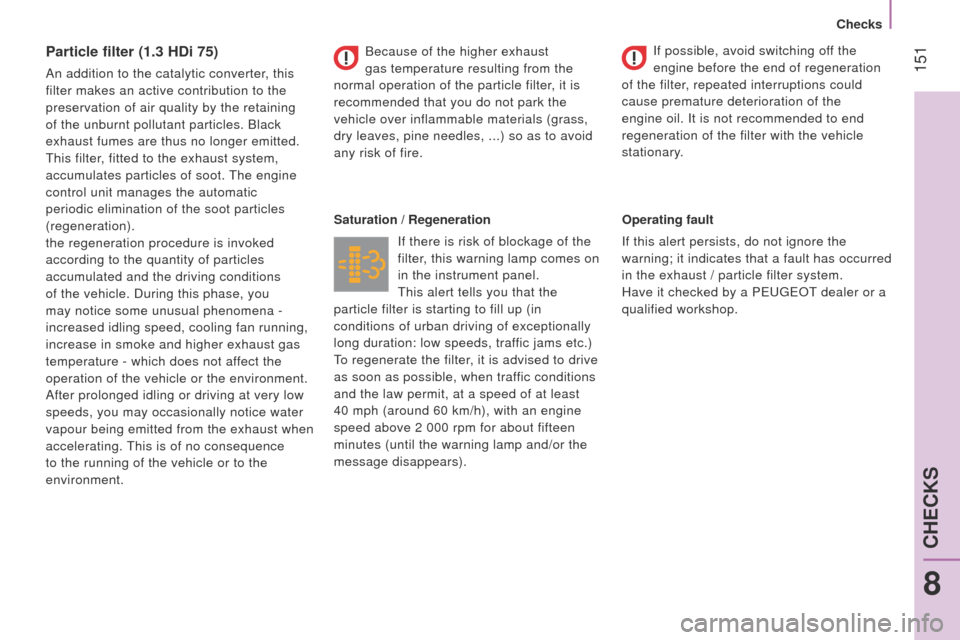air filter Peugeot Bipper 2014.5 Owner's Manual - RHD (UK, Australia)
[x] Cancel search | Manufacturer: PEUGEOT, Model Year: 2014.5, Model line: Bipper, Model: Peugeot Bipper 2014.5Pages: 192, PDF Size: 7.93 MB
Page 5 of 192

3
Bipper_en_Chap00a_sommaire_ed02-2014
TECHNICAL DATA
10.
174-183ACCESSORIES
7.
137-140
towing a trailer ,
caravan, etc... 137
Roof rack and
roof bars
139
Other accessories
139Filling with fuel
142
Opening the bonnet
144
Diesel engine
145
Petrol engine
146l
evels
147
Checks
149
Particle filter
(Diesel)
151
QUICK HELP
9.
152-173
CHECKS
8.
141-151
Battery 152
Changing a wheel 155temporary puncture repair
kit
158
Snow chains
160
Changing a bulb
161
Changing a wiper blade
166
Changing a fuse
167towing the vehicle
172Dimensions
174
Engines
180
W
eights
182
Identification
markings
183
corresponds to a left hand
drive vehicle.
corresponds to a right
hand drive vehicle.
CONteNtS
Contents
Page 18 of 192

16
Bipper_en_Chap01_vue-ensemble_ed02-2014
emission controls ....................34, 151
Bulbs, lighting, changing
bulbs
.......
.............................
161-165
Opening the bonnet
....................... 144
u
nder the bonnet
....................
145-146
Identification markings, serial number, paint, tyres
.......
........................... 183 Changing a wiper blade
.................
166
e
ngine technical data
.............180-181
Dimensions
............................ 174-175,
176-177. 178-179
Weights
.......................................... 182
TECHNICAL DATA - MAINTENANCE
levels .....................................147-14 8
●
dipstick,
●
power steering fluid,
●
brake fluid,
●
coolant,
●
screenw
ash.
Checks.................................... 149-151
●
battery
,
●
air/passenger compartment filter
,
●
oil filter
,
●
particle emissions filter (1.3 HDi 75),
●
parking brake,
●
brake pads.
e
ngine fuses
...................167, 170-171
Location
Page 26 of 192

24
Bipper_en_Chap02_eco-conduite_ed02-2014
Limit the causes of excess consumption
Spread loads throughout the vehicle; place the heaviest items in the
bottom of the boot, as close as possible to the rear seats.
l
imit the loads carried in the vehicle and reduce wind resistance (roof \
bars, roof rack, bicycle carrier, trailer...).
u se a roof box in preference.
Remove roof bars and roof racks after use.
At the end of winter, remove snow tyres and refit your summer tyres.
Observe the recommendations on maintenance
Check the tyre pressures regularly, when cold, referring to the label in
the door aperture, driver's side.
Carry out this check in particular:
-
before a long journey
,
-
at each change of season,
-
after a long period out of use.
Don't forget the spare wheel and the tyres on any trailer or caravan.
Have your vehicle serviced regularly (engine oil, oil filter
, air filter,
passenger compartment filter...) and observe the schedule of
operations recommended in the warranty and maintenance record.
When refuelling, do not continue after the third cut-off of the nozzle to
avoid any overflow.
At the wheel of your new vehicle, it is only after the first 1 800 miles
(3
000 kilometres) that you will see the fuel consumption settle down to
a consistent average.
Motoring & Environment
Page 73 of 192

71
Bipper_en_Chap04_ergonomie_ed02-2014
DEMISTING AND DEFROSTING
Windscreen
t
he vents located at the base of the
windscreen and the side vents for the side
windows increase the effectiveness of the
demisting and defrosting. Do not obstruct
these eight vents.
t
he manual air conditioning includes a
pollen filter and air recirculation.
t
he pollen filter permits continuous and
effective filtering of dust.
Air recirculation (which can be operated by
the driver or the passenger) isolates the
passenger compartment from the exterior
atmosphere. However, this position should
only be used temporarily, you should
normally drive with the control in the exterior
air intake position. Manual mode
turn the control to this air
distribution setting.
For faster and more effective
demisting and defrosting of the
windscreen:
-
increase the air flow setting,
Return to the exterior air intake
position as soon as possible to
allow renewal of the air in the
passenger compartment. Rear screen and mirrors defrosting
t
his function only operates when
the engine is running. Pressing
this button activates the rapid
demisting/defrosting of the rear
screen and mirrors.
t
his function switches
off automatically to prevent an excessive
consumption of energy. It switches off when
the engine is switched off. Pressing this
button switches the function off.
-
move the exterior air intake
control temporarily to air
recirculation.
4
EASE OF USE and COMFORT
Ventilation
Page 75 of 192

73
Bipper_en_Chap04_ergonomie_ed02-2014
CORRECT USE OF THE AIR
CONDITIONING
Operate the air conditioning system for
5 to 10 minutes, once or twice a month,
to keep it in perfect working order.
Have the filter elements (air filter and
passenger compartment filter) replaced
regularly. If you drive in a dusty environment,
have them replaced twice as often.
It is normal that the condensation created by
the air conditioning system results in a flow
of water which may form a puddle under the
vehicle when parked.
If the system does not produce cold air, do
not use it and contact a P
euge O t
dealer or
a qualified workshop.VENTS
For optimum distribution and diffusion of hot
or cool air in the passenger compartment,
there are:
-
2 adjustable central vents,
-
2 adjustable and closing side vents,
-
2 vents directed towards the floor of the
vehicle.
In order to be effective, the air conditioning
should only be used with the windows
closed. However, if the interior temperature
is high after a prolonged period parked
in the sun, first ventilate the passenger
compartment for a few minutes.
For even air distribution, ensure that the
exterior air intake grille located at the base
of the windscreen is not obstructed and that
the side and central vents, the air outlets on
the floor and the air extractor at the rear are
open.
t
he air conditioning is useful in all seasons
as it eliminates condensation and air
humidity.
4
EASE OF USE and COMFORT
Ventilation
Page 147 of 192

145
Bipper_en_Chap08_verifications_ed02-2014
DIESEL ENGINE
take care when doing anything under
the bonnet.
1.
Screenwash reservoir
.
2.
Fusebox.
3.
e
ngine coolant header tank.
4.
Brake and clutch fluid reservoir
.
5.
Air filter
.
6.
Dipstick.
7.
e
ngine oil filler cap.
8.
Power steering fluid reservoir
.
8
CHECKS
Under the bonnet
Page 148 of 192

146
Bipper_en_Chap08_verifications_ed02-2014
PETROL ENGINE
take care when doing anything under
the bonnet.
1.
Screenwash reservoir
.
2.
Fusebox.
3.
e
ngine coolant header tank.
4.
Brake and clutch fluid reservoir
.
5.
Air filter
.
6.
Dipstick.
7.
e
ngine oil filler cap.
8.
Power steering fluid reservoir
.
Under the bonnet
Page 151 of 192

149
Bipper_en_Chap08_verifications_ed02-2014
CHECKS
Bleeding water from the Diesel filter
If this warning lamp comes
on, you must bleed the filter;
otherwise bleed the filter
regularly, every time the engine
oil is changed.
to remove the water
, unscrew the bleed
screw or the water in Diesel sensor, located
at the base of the filter. Operate until all of
the water has flowed out.
t
hen tighten the
bleed screw or the water sensor.
Battery
At the start of winter, have your battery
checked by a P euge O t
dealer or a
qualified workshop.
Air filter and passenger compartment
filter
A blocked passenger compartment filter
may reduce the performance of the
air conditioning system and generate
undesirable odours.
t
he replacement
intervals for these components are indicated
in the warranty and maintenance record.
Depending on the environment (dusty
atmosphere...) and the use of the vehicle
(urban driving...), change them twice as
often if necessary.
Brake pads
Brake pad wear depends on the type of
driving, in particular for vehicles which are
used in town, over short distances. It may
be necessary to check the brake pad wear,
even between services.
u
nless there is a leak on the system, a drop
in the brake fluid level indicates that the
brake pads are worn.
Brake disc / drum wear
For all information on checking the brake
disc / drum wear, contact a P euge O t
dealer or a qualified workshop.
Parking brake
Where the parking brake travel is too great
or there is a reduction in the performance
of the system, the parking brake should be
adjusted, even between services.
Have the system checked by a P
euge O t
dealer or a qualified workshop.
Oil filter
Change the filter regularly, in accordance
with the manufacturer's servicing schedule.
t
he presence of this label, in particular
with the Stop & Start system, indicates the
use of a specific 12 V lead-acid battery
with special technology and specification.
t
he involvement of a P
euge
O
t
dealer
or a qualified workshop is essential when
replacing or disconnecting the battery.
Refer to the "Checks -
u
nder the
bonnet" section.
HDi engines use advanced
technology. All work requires
specialist knowledge, which all P
euge
O
t
dealers have.
8
CHECKS
Checks
Page 153 of 192

151
Bipper_en_Chap08_verifications_ed02-2014
Particle filter (1.3 HDi 75)
An addition to the catalytic converter, this
filter makes an active contribution to the
preservation of air quality by the retaining
of the unburnt pollutant particles. Black
exhaust fumes are thus no longer emitted.
t
his filter, fitted to the exhaust system,
accumulates particles of soot.
t
he engine
control unit manages the automatic
periodic elimination of the soot particles
(regeneration).
the regeneration procedure is invoked
according to the quantity of particles
accumulated and the driving conditions
of the vehicle. During this phase, you
may notice some unusual phenomena -
increased idling speed, cooling fan running,
increase in smoke and higher exhaust gas
temperature
- which does not affect the
operation of the vehicle or the environment.
After prolonged idling or driving at very low
speeds, you may occasionally notice water
vapour being emitted from the exhaust when
accelerating.
t
his is of no consequence
to the running of the vehicle or to the
environment. Saturation / Regeneration
If there is risk of blockage of the
filter, this warning lamp comes on
in the instrument panel.
t
his alert tells you that the
particle filter is starting to fill up (in
conditions of urban driving of exceptionally
long duration: low speeds, traffic jams etc.)
to regenerate the filter
, it is advised to drive
as soon as possible, when traffic conditions
and the law permit, at a speed of at least
40 mph (around 60 km/h), with an engine
speed above 2 000 rpm for about fifteen
minutes (until the warning lamp and/or the
message disappears). Operating fault
If this alert persists, do not ignore the
warning; it indicates that a fault has occurred
in the exhaust / particle filter system.
Have it checked by a P
euge O t
dealer or a
qualified workshop.
Because of the higher exhaust
gas temperature resulting from the
normal operation of the particle filter, it is
recommended that you do not park the
vehicle over inflammable materials (grass,
dry leaves, pine needles,
...) so as to avoid
any risk of fire. If possible, avoid switching off the
engine before the end of regeneration
of the filter, repeated interruptions could
cause premature deterioration of the
engine oil. It is not recommended to end
regeneration of the filter with the vehicle
stationary.
8
CHECKS
Checks